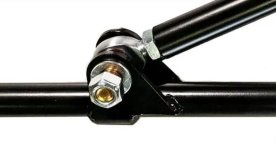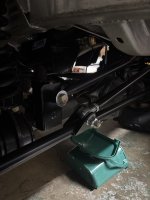I’ll try to carefully tread on the radius arm topic, my gut response many here would find offensive. My goal is never to tell anyone how to build their rig, I will strongly suggest, but never dictate. I want to be educational and will never tell anyone their ideas or what they have built is terrible unless I see something that makes me fearful for the safety of yourself and/or those bystanders. So if you like radius arms please build them, but it won’t stop me from politely trying to talk you out of it.
If doing that level of work, cut the upper link off the radius arm and add a frame bracket for that upper link. Then all of that weirdness goes away. Then you have a suspension that can be tuned to handle the way you want and everything is happy.
Radius arms have terrible dynamics, binding the axle trying to tear it in 2 is a poor tuning tool. Let alone the issues with wheel hop when the tires are spinning, hopping tires have no traction and kill parts. When that available leverage from traction can be turned into more traction is when things move forward. Radius arms take traction and turn it into less traction, unless your in reverse, then the available traction gets the opposite affect and will increase traction to the point that the leverage forces the axle to crawl back underneath itself until is is broken, that is why you don’t see radius arms in the rear.
Now back to drivability of this vehicle in question. Is it ideal? No. Is it the worst idea? No. Can it be used as is to accomplish the OP’s goals? I believe so. If I was 2500 miles closer we would be having less keyboard discussion and it would be fixed lol.
If doing that level of work, cut the upper link off the radius arm and add a frame bracket for that upper link. Then all of that weirdness goes away. Then you have a suspension that can be tuned to handle the way you want and everything is happy.
Radius arms have terrible dynamics, binding the axle trying to tear it in 2 is a poor tuning tool. Let alone the issues with wheel hop when the tires are spinning, hopping tires have no traction and kill parts. When that available leverage from traction can be turned into more traction is when things move forward. Radius arms take traction and turn it into less traction, unless your in reverse, then the available traction gets the opposite affect and will increase traction to the point that the leverage forces the axle to crawl back underneath itself until is is broken, that is why you don’t see radius arms in the rear.
Now back to drivability of this vehicle in question. Is it ideal? No. Is it the worst idea? No. Can it be used as is to accomplish the OP’s goals? I believe so. If I was 2500 miles closer we would be having less keyboard discussion and it would be fixed lol.
Last edited:












